Expression of Selected Ginkgo biloba Heat Shock Protein Genes After Cold Treatment Could Be Induced by Other Abiotic Stress
Abstract
:1. Introduction
2. Results and Discussion
2.1. Results
2.1.1. Cloning and Sequence Analyses of Three Genes Encoding Heat Shock Protein from Ginkgo biloba
2.1.2. Expression Analysis of Three GbHSPs Genes in Different Tissues
2.1.3. Expression Profiles of the Three HSPs under Low Temperature or Heat Shock Treatments at Seedling Stage
2.1.4. Expression Patterns of the Three GbHSPs under Abiotic Stresses
2.2. Discussion
2.2.1. GbHSPs Are Expressed under Normal Conditions with Tissue Preference
2.2.2. GbHSPs Expression Is Generally Enhanced under Cold or Heat Stress
2.2.3. GbHSPs Can Also Be Induced by Stresses Other than Temperature Stress
3. Experimental Section
3.1. Plant Materials and Treatments
3.2. Subtractive Hybridization
3.3. Molecular Cloning of the GbHSPs cDNA
3.4. Relative Quantification by QRT-PCR
3.5. Statistics
4. Conclusions
Acknowledgments
References
- Ballinger, D.G.; Pardue, M.L. The control of protein synthesis during heat shock in Drosophila cells involves altered polypeptide elongation rates. Cell 1983, 33, 103–113. [Google Scholar]
- Wang, W.; Vinocur, B.; Shoseyov, O.; Altman, A. Role of plant heat-shock proteins and molecular chaperones in the abiotic stress response. Trends Plant Sci 2004, 9, 244–252. [Google Scholar]
- Sørensen, J.G.; Kristensen, T.N.; Loeschcke, V. The evolutionary and ecological role of heat shock proteins. Ecol. Lett 2003, 6, 1025–1037. [Google Scholar]
- Sun, W.; van Montagu, M.; Verbruggen, N. Small heat shock proteins and stress tolerance in plants. Biochim. Biophys. Acta 2002, 1577, 1–9. [Google Scholar]
- Zou, J.; Liu, A.; Chen, X.; Zhou, X.; Gao, G.; Wang, W.; Zhang, X. Expression analysis of nine rice heat shock protein genes under abiotic stresses and ABA treatment. J. Plant Physiol 2009, 166, 851–861. [Google Scholar]
- Vierling, E. The roles of heat shock proteins in plants. Annu. Rev. Plant Physiol. Plant Mol. Biol 1991, 42, 579–620. [Google Scholar]
- Sejerkilde, M.; Sørensen, J.G.; Loeschcke, V. Effects of cold-and heat hardening on thermal resistance in Drosophila melanogaster. J. Insect Physiol 2003, 49, 719–726. [Google Scholar]
- Tammariello, S.P.; Rinehart, J.P.; Denlinger, D.L. Desiccation elicits heat shock protein transcription in the flesh fly, Sarcophaga crassipalpis, but does not enhance tolerance to high or low temperatures. J. Insect Physiol 1999, 45, 933–938. [Google Scholar]
- Tedengren, M.; Olsson, B.; Bradley, B.; Zhou, L. Heavy metal uptake, physiological response and survival of the blue mussel (Mytilus edulis) from marine and brackish waters in relation to the induction of heat-shock protein 70. Hydrobiologia 1999, 393, 261–269. [Google Scholar]
- Spees, J.L.; Chang, S.A.; Snyder, M.J.; Chang, E.S. Osmotic induction of stress-responsive gene expression in the lobster Homarus americanus. Biol. Bull 2002, 203, 331–337. [Google Scholar]
- Ma, E.; Haddad, G.G. Anoxia regulates gene expression in the central nervous system of Drosophila melanogaster. Mol. Brain Res 1997, 46, 325–328. [Google Scholar]
- Rinehart, J.P.; Denlinger, D.L.; Rivers, D.B. Upregulation of transcripts encoding select heat shock proteins in the flesh fly Sarcophaga crassipalpis in response to venom from the ectoparasitoid wasp Nasonia vitripennis. J. Invertebr. Pathol 2002, 79, 62–63. [Google Scholar]
- Murakami, T.; Matsuba, S.; Funatsuki, H.; Kawaguchi, K.; Saruyama, H.; Tanida, M.; Sato, Y. Over-expression of a small heat shock protein, sHSP17.7, confers both heat tolerance and UV-B resistance to rice plants. Mol. Breed 2004, 13, 165–175. [Google Scholar]
- Niedzwiecki, A.; Reveillaud, I.; Fleming, J.E. Changes in superoxide dismutase and catalase in aging heat-shocked Drosophila. Free Radic. Res. Commun 1992, 17, 355–367. [Google Scholar]
- Musch, M.W.; Kapil, A.; Chang, E.B. Heat shock protein 72 binds and protects dihydrofolate reductase against oxidative injury. Biochem Biophys. Res. Commun 2004, 313, 185–192. [Google Scholar]
- Campbell, J.L.; Klueva, N.Y.; Zheng, H.; Nieto-Sotelo, J.; Ho, T.H.; Nguyen, H.T. Cloning of new members of heat shock protein HSP101 gene family in wheat (Triticum aestivum (L.) Moench) inducible by heat, dehydration, and ABA. Biochim. Biophys. Acta 2001, 1517, 270–277. [Google Scholar]
- Chang, P.F.; Jinn, T.L.; Huang, W.K.; Chen, Y.; Chang, H.M.; Wang, C.W. Induction of a cDNA clone from rice encoding a class II small heat shock protein by heat stress, mechanical injury, and salicylic acid. Plant Sci 2007, 172, 64–75. [Google Scholar]
- Lewis, J.; Devin, A.; Miller, A.; Lin, Y.; Rodriguez, Y.; Neckers, L.; Liu, Z. Disruption of hsp90 function results in degradation of the death domain kinase, receptor-interacting protein (RIP), and blockage of tumor necrosis factor-induced nuclear factor-κB activation. J. Biol. Chem 2000, 275, 10519–10526. [Google Scholar]
- Pandey, P.; Saleh, A.; Nakazawa, A.; Kumar, S.; Srinivasula, S.M.; Kumar, V.; Weichselbaum, R.; Nalin, C.; Alnemri, E.S.; Kufe, D. Negative regulation of cytochrome c-mediated oligomerization of Apaf-1 and activation of procaspase-9 by heat shock protein 90. EMBO J 2000, 19, 4310–4322. [Google Scholar]
- Volkov, R.A.; Panchuk, I.I.; Schöffl, F. Small heat shock proteins are differentially regulated during pollen development and following heat stress in tobacco. Plant Mol. Biol 2005, 57, 487–502. [Google Scholar]
- Sanmiya, K.; Suzuki, K.; Egawa, Y.; Shono, M. Mitochondrial small heat-shock protein enhances thermotolerance in tobacco plants. FEBS. Lett 2004, 557, 265–268. [Google Scholar]
- Guo, S.J.; Zhou, H.Y.; Zhang, X.S.; Li, X.G.; Meng, Q.W. Overexpression of CaHSP26 in transgenic tobacco alleviates photoinhibition of PSII and PSI during chilling stress under low irradiance. J. Plant Physiol 2007, 164, 126–136. [Google Scholar]
- Sato, Y.; Yokoya, S. Enhanced tolerance to drought stress in transgenic rice plants overexpressing a small heat-shock protein, sHSP17.7. Plant Cell Rep 2008, 27, 329–334. [Google Scholar]
- Smith, J.; Luo, Y. Studies on molecular mechanisms of Ginkgo biloba extract. Appl. Microbiol. Biotechnol 2004, 64, 465–472. [Google Scholar]
- van Beek, T. Chemical analysis of Ginkgo biloba leaves and extracts. J. Chromatogr. A 2002, 967, 21–55. [Google Scholar]
- Deng, Z.; Wang, Y.; Jiang, K.; Liu, X.; Wu, W.; Gao, S.; Lin, J.; Sun, X.; Tang, K. Molecular cloning and characterization of a novel dehydrin gene from Ginkgo biloba. Biosci. Rep 2006, 26, 203–215. [Google Scholar]
- Mayer, M.; Bukau, B. Hsp70 chaperones: Cellular functions and molecular mechanism. Cell Mol. Life Sci 2005, 62, 670–684. [Google Scholar]
- Wu, X.; Yano, M.; Washida, H.; Kido, H. The second metal-binding site of 70 kDa heat-shock protein is essential for ADP binding, ATP hydrolysis and ATP synthesis. Biochem. J 2004, 378, 793–799. [Google Scholar]
- Morshauser, R.C.; Wang, H.; Flynn, G.C.; Zuiderweg, E.R. The peptide-binding domain of the chaperone protein Hsc70 has an unusual secondary structure topology. Biochemistry 1995, 34, 6261–6266. [Google Scholar]
- Morshauser, R.C.; Hu, W.; Wang, H.; Pang, Y.; Flynn, G.C.; Zuiderweg, E.R. High-resolution solution structure of the 18 kDa substrate-binding domain of the mammalian chaperone protein Hsc701. J. Mol. Biol 1999, 289, 1387–1403. [Google Scholar]
- Bondino, H.G.; Valle, E.M. Evolution and functional diversification of the small heat shock protein α-crystallin family in higher plants. Planta 2011. [Google Scholar] [CrossRef]
- Waters, E.R.; Lee, G.J.; Vierling, E. Evolution, structure and function of the small heat shock proteins in plants. J. Exp. Bot 1996, 47, 325–338. [Google Scholar]
- Plesofsky-Vig, N.; Vig, J.; Brambl, R. Phylogeny of the α-crystallin-related heat-shock proteins. J. Mol. Evol 1992, 35, 537–545. [Google Scholar]
- Horwitz, J. Alpha-crystallin can function as a molecular chaperone. Proc. Natl. Acad. Sci. USA 1992, 89, 10449–10453. [Google Scholar]
- Merck, K.; Groenen, P.; Voorter, C.; de Haard-Hoekman, W.; Horwitz, J.; Bloemendal, H.; De, J.W. Structural and functional similarities of bovine α-crystallin and mouse small heat-shock protein A family of chaperones. J. Biol. Chem 1993, 268, 1046–1062. [Google Scholar]
- Kim, K.K.; Kim, R.; Kim, S.H. Crystal structure of a small heat-shock protein. Nature 1998, 394, 595–599. [Google Scholar]
- Löw, D.; Brändle, K.; Nover, L.; Forreiter, C. Cytosolic heat-stress proteins Hsp17.7 class I and Hsp17.3 class II of tomato act as molecular chaperones in vivo. Planta 2000, 211, 575–582. [Google Scholar]
- Stevenson, M.; Calderwood, S. Members of the 70-kilodalton heat shock protein family contain a highly conserved calmodulin-binding domain. Mol. Cell Biol 1990, 10, 1234–1238. [Google Scholar]
- Zhang, Z.; Quick, M.K.; Kanelakis, K.C.; Gijzen, M.; Krishna, P. Characterization of a plant homolog of hop, a cochaperone of hsp90. Plant Physiol 2003, 131, 525–535. [Google Scholar]
- Sung, D.Y.; Vierling, E.; Guy, C.L. Comprehensive expression profile analysis of the Arabidopsis Hsp70 gene family. Plant Physiol 2001, 126, 789–800. [Google Scholar]
- Koo, H.J.; Xia, X.; Hong, C.B. Genes and expression pattern of tobacco mitochondrial small heat shock protein under high-temperature stress. J. Plant Biol 2003, 46, 204–210. [Google Scholar]
- Guan, J.C.; Jinn, T.L.; Yeh, C.H.; Feng, S.P.; Chen, Y.M.; Lin, C.Y. Characterization of the genomic structures and selective expression profiles of nine class I small heat shock protein genes clustered on two chromosomes in rice (Oryza sativa L.). Plant Mol. Biol 2004, 56, 795–809. [Google Scholar]
- Sun, W.; Bernard, C.; Van, De.; Cotte, B.; Van Montagu, M.; Verbruggen, N. At-HSP17.6A encoding a small heat-shock protein in Arabidopsis, can enhance osmotolerance upon overexpression. Plant J 2001, 27, 407–415. [Google Scholar]
- Collins, G.G.; Nie, X.L.; Saltveit, M.E. Heat shock proteins and chilling sensitivity of mung bean hypocotyls. J. Exp. Bot 1995, 46, 795–802. [Google Scholar]
- Anderson, J.V.; Li, Q.B.; Haskell, D.W.; Guy, C.L. Structural organization of the spinach endoplasmic reticulum-luminal 70-kilodalton heat-shock cognate gene and expression of 70-kilodalton heat-shock genes during cold acclimation. Plant Physiol 1994, 104, 1359–1370. [Google Scholar]
- Lopez-Matas, M.A.; Nuñez, P.; Soto, A.; Allona, I.; Casado, R.; Collada, C.; Guevara, M.A.; Aragoncillo, C.; Gomez, L. Protein cryoprotective activity of a cytosolic small heat shock protein that accumulates constitutively in chestnut stems and is up-regulated by low and high temperatures. Plant Physiol 2004, 134, 1708–1717. [Google Scholar]
- Krishna, P.; Sacco, M.; Cherutti, J.F.; Hill, S. Cold-induced accumulation of hsp90 transcripts in Brassica napus. Plant Physiol 1995, 107, 915–923. [Google Scholar]
- Soto, A.; Allona, I.; Collada, C.; Guevara, M.A.; Casado, R.; Rodriguez-Cerezo, E.; Aragoncillo, C.; Gomez, L. Heterologous expression of a plant small heat-shock protein enhances Escherichia coli viability under heat and cold stress. Plant Physiol 1999, 120, 521–528. [Google Scholar]
- Wang, L.; Zhao, C.M.; Wang, Y.J.; Liu, J. Overexpression of chloroplast-localized small molecular heat-shock protein enhances chilling tolerance in tomato plant. J. Plant Physiol. Mol. Biol 2005, 31, 167–174. [Google Scholar]
- Guo, S.J.; Chen, N.; Guo, P.; Meng, Q.W. cDNA cloning and expression of a cytosolic small heat shock protein gene (CaHSP18) from Capsicum annuum. J. Plant Physiol. Mol. Biol 2005, 31, 409–416. [Google Scholar]
- Zhu, W.; Lu, M.; Gong, Z.; Chen, R. Cloning and expression of a small heat shock protein gene CaHSP24 from pepper under abiotic stress. Afr. J. Biotechnol 2011, 10, 4968–4975. [Google Scholar]
- Morimoto, R. Cells in stress: Transcriptional activation of heat shock genes. Science 1993, 259, 1409–1450. [Google Scholar]
- Krizek, D.T.; Kramer, G.F.; Upadhyaya, A.; Mirecki, R.M. UV-B response of cucumber seedlings grown under metal halide and high pressure sodium-deluxe lamps. Physiol. Plant 1993, 88, 350–358. [Google Scholar]
- Strid, Å. Alteration in expression of defence genes in Pisum sativum after exposure to supplementary ultraviolet-B radiation. Plant Cell Physiol 1993, 34, 949–953. [Google Scholar]
- Banzet, N.; Richaud, C.; Deveaux, Y.; Kazmaier, M.; Gagnon, J.; Triantaphylidès, C. Accumulation of small heat shock proteins, including mitochondrial HSP22, induced by oxidative stress and adaptive response in tomato cells. Plant J 1998, 13, 519–527. [Google Scholar]
- Hamilton, E.W.; Heckathorn, S.A. Mitochondrial adaptations to NaCl. Complex I is protected by anti-oxidants and small heat shock proteins, whereas complex II is protected by proline and betaine. Plant Physiol 2001, 126, 1266–1274. [Google Scholar]
- Kang, H.M.; Saltveit, M.E. Wound-induced PAL activity is suppressed by heat-shock treatments that induce the synthesis of heat-shock proteins. Physiol. Plant 2003, 119, 450–455. [Google Scholar]
- Leonardi, R.; Villari, L.; Caltabiano, M.; Travali, S. Heat shock protein 27 expression in the epithelium of periapical lesions. J. Endod 2001, 27, 89–92. [Google Scholar]
- Cho, E.K.; Hong, C.B. Over-expression of tobacco NtHSP70-1 contributes to drought-stress tolerance in plants. Plant Cell Rep 2006, 25, 349–358. [Google Scholar]
- Hu, X.; Liu, R.; Li, Y.; Wang, W.; Tai, F.; Xue, R.; Li, C. Heat shock protein 70 regulates the abscisic acid-induced antioxidant response of maize to combined drought and heat stress. Plant Growth Regul 2010, 60, 225–235. [Google Scholar]
- Daie, J.; Campbell, W.F. Response of tomato plants to stressful temperatures: Increase in abscisic acid concentrations. Plant Physiol 1981, 67, 26–29. [Google Scholar]
- Ye, S.F.; Yu, S.W.; Shu, L.B.; Wu, J.H.; Wu, A.Z.; Luo, L.J. Expression profile analysis of 9 heat shock protein genes throughout the life cycle and under abiotic stress in rice. Chin. Sci. Bull 2011, 57, 336–343. [Google Scholar]
- Xu, F.; Cheng, H.; Cai, R.; Li, L.L.; Chang, J.; Zhu, J.; Zhang, F.X.; Chen, L.J.; Wang, Y.; Cheng, S.H. Molecular cloning and function analysis of an anthocyanidin synthase gene from Ginkgo biloba, and its expression in abiotic stress responses. Mol. Cells 2008, 26, 536–547. [Google Scholar]
- Jansson, S.; Meyer-Gauen, G.; Cerff, R.; Martin, W. Nucleotide distribution in gymnosperm nuclear sequences suggests a model for GC-content change in land-plant nuclear genomes. J. Mol. Evol 1994, 39, 34–46. [Google Scholar]
- NCBI Basic Local Alignment Search Tool. Available online: http://www.ncbi.nlm.nih.gov/blast/Blast.cgi accessed on 5 October 2011.
- Tamura, K.; Dudley, J.; Nei, M.; Kumar, S. MEGA4: Molecular evolutionary genetics analysis (MEGA) software version 4.0. Mol. Biol. Evol 2007, 24, 1596–1599. [Google Scholar]
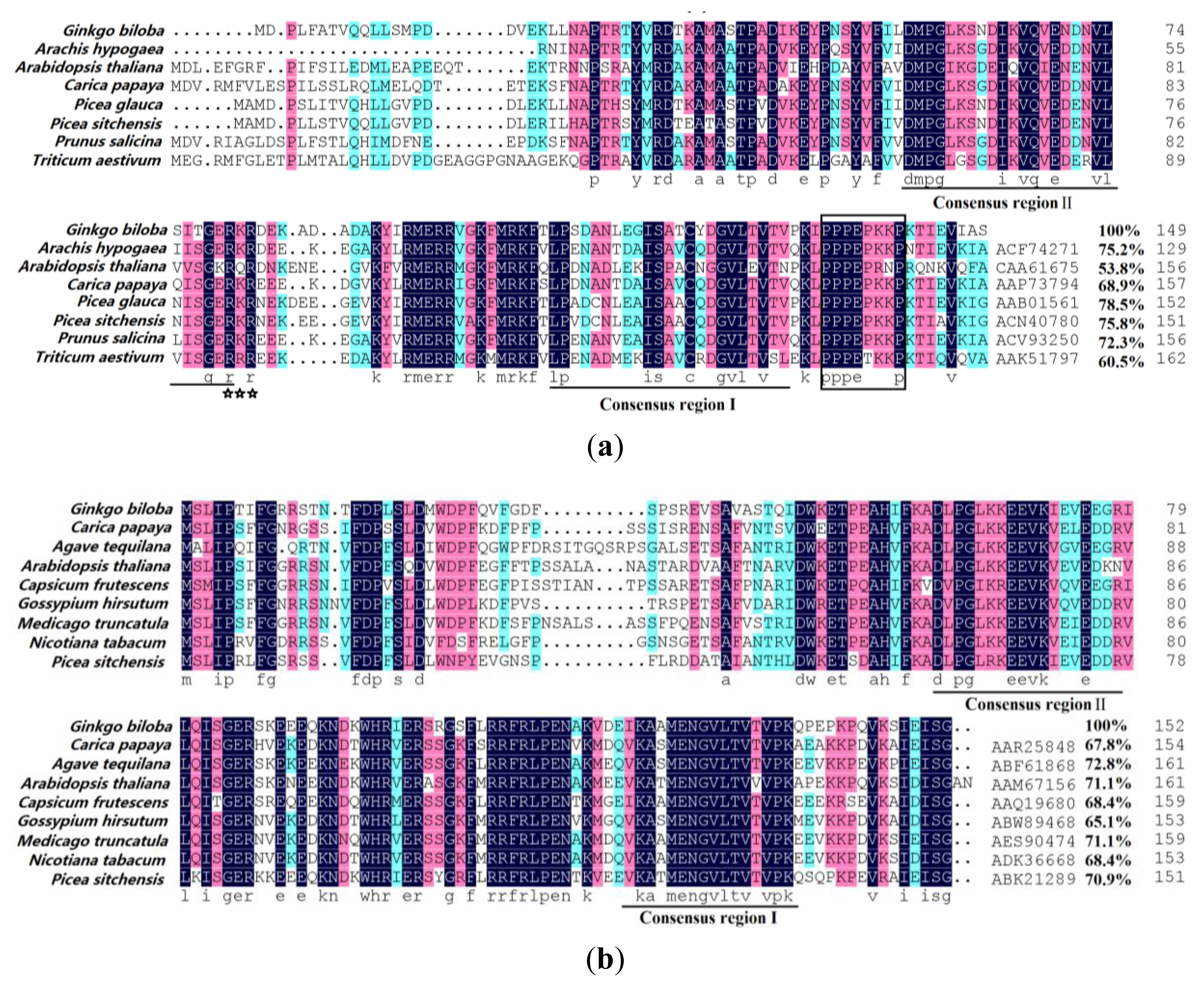

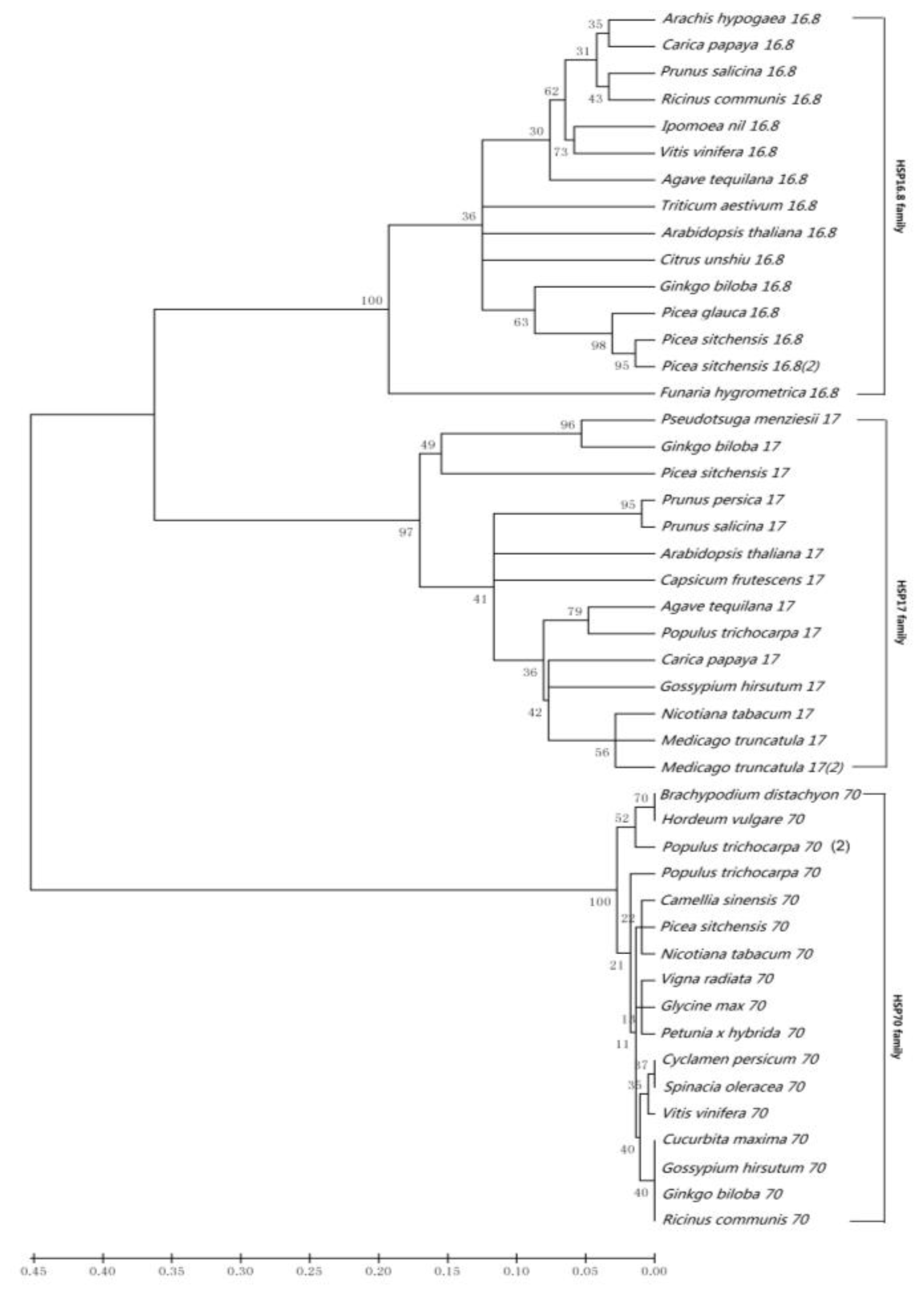
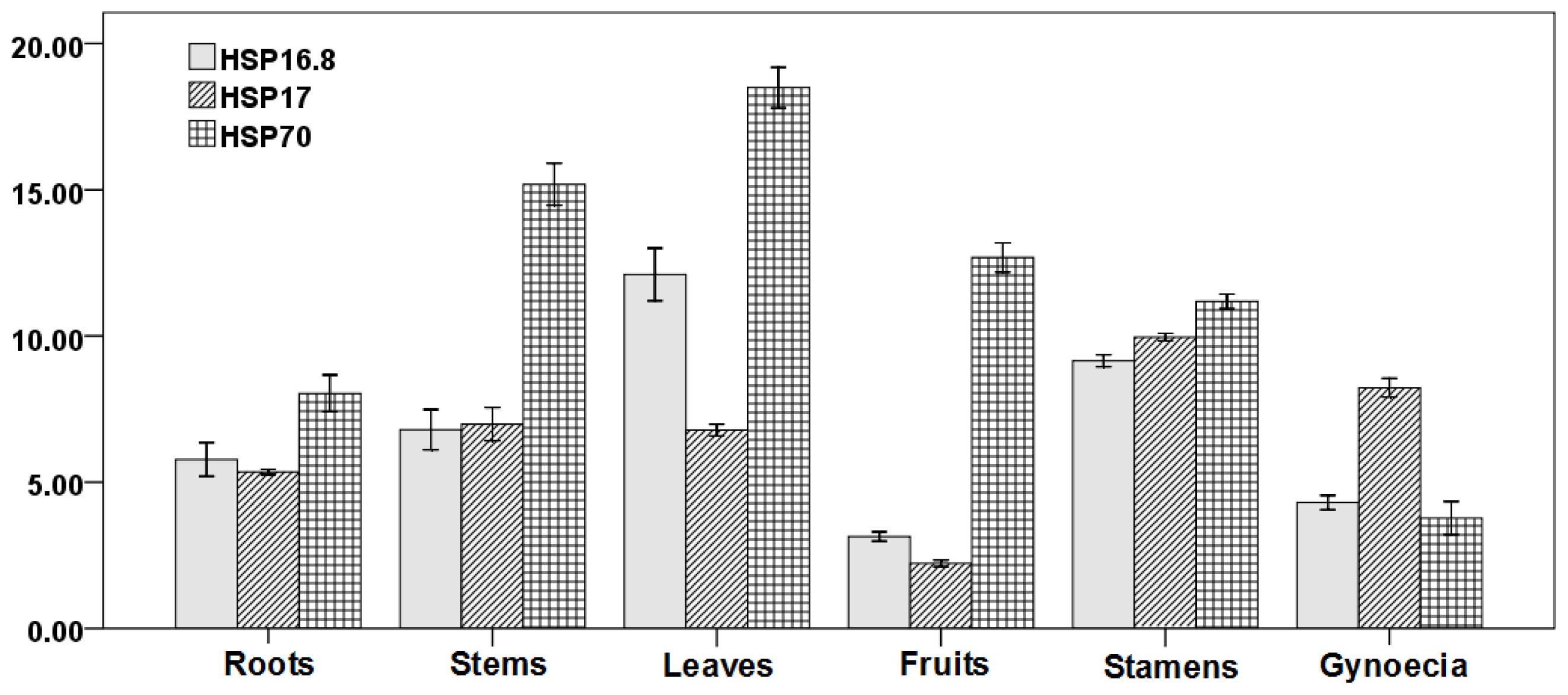
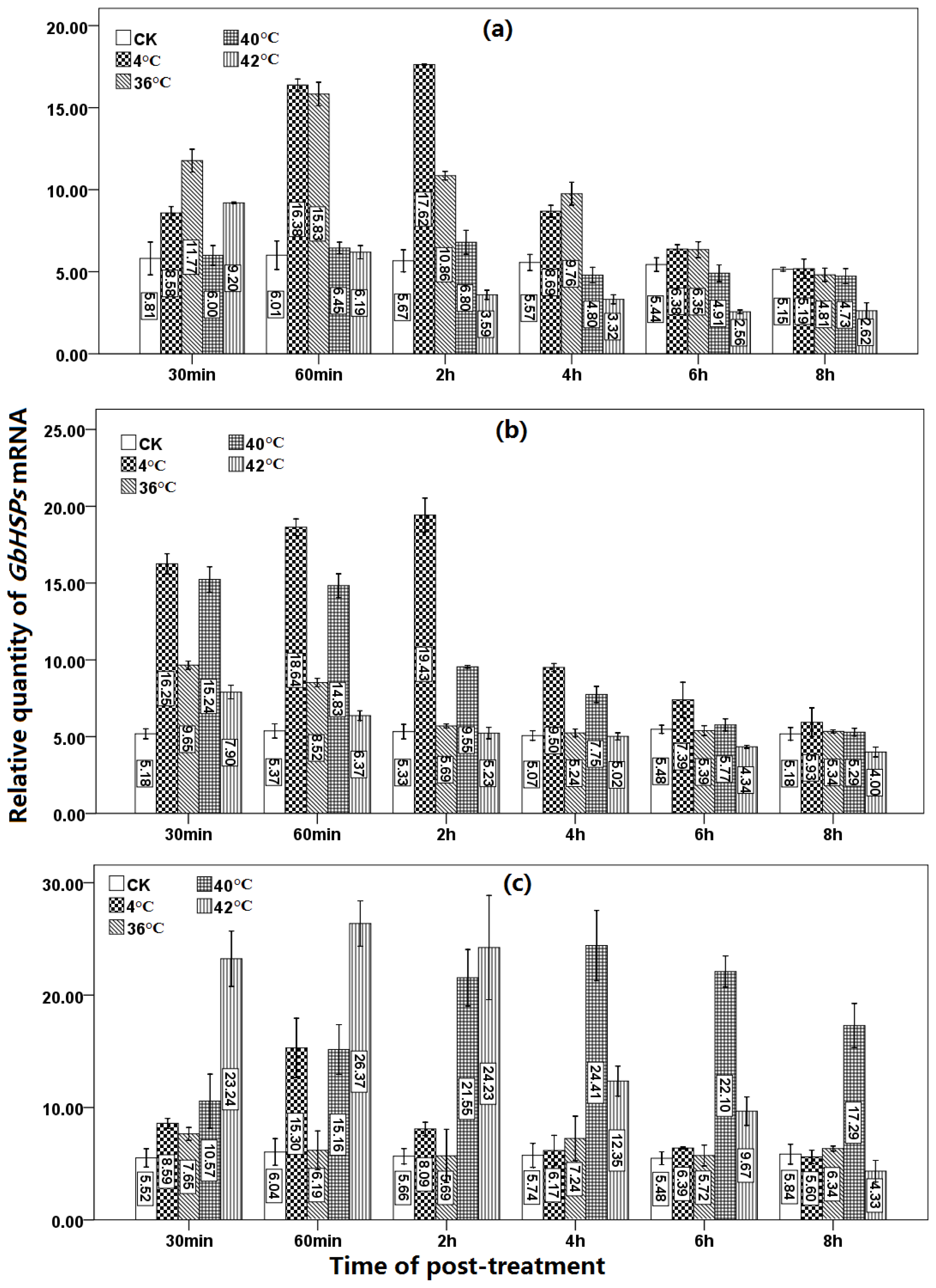
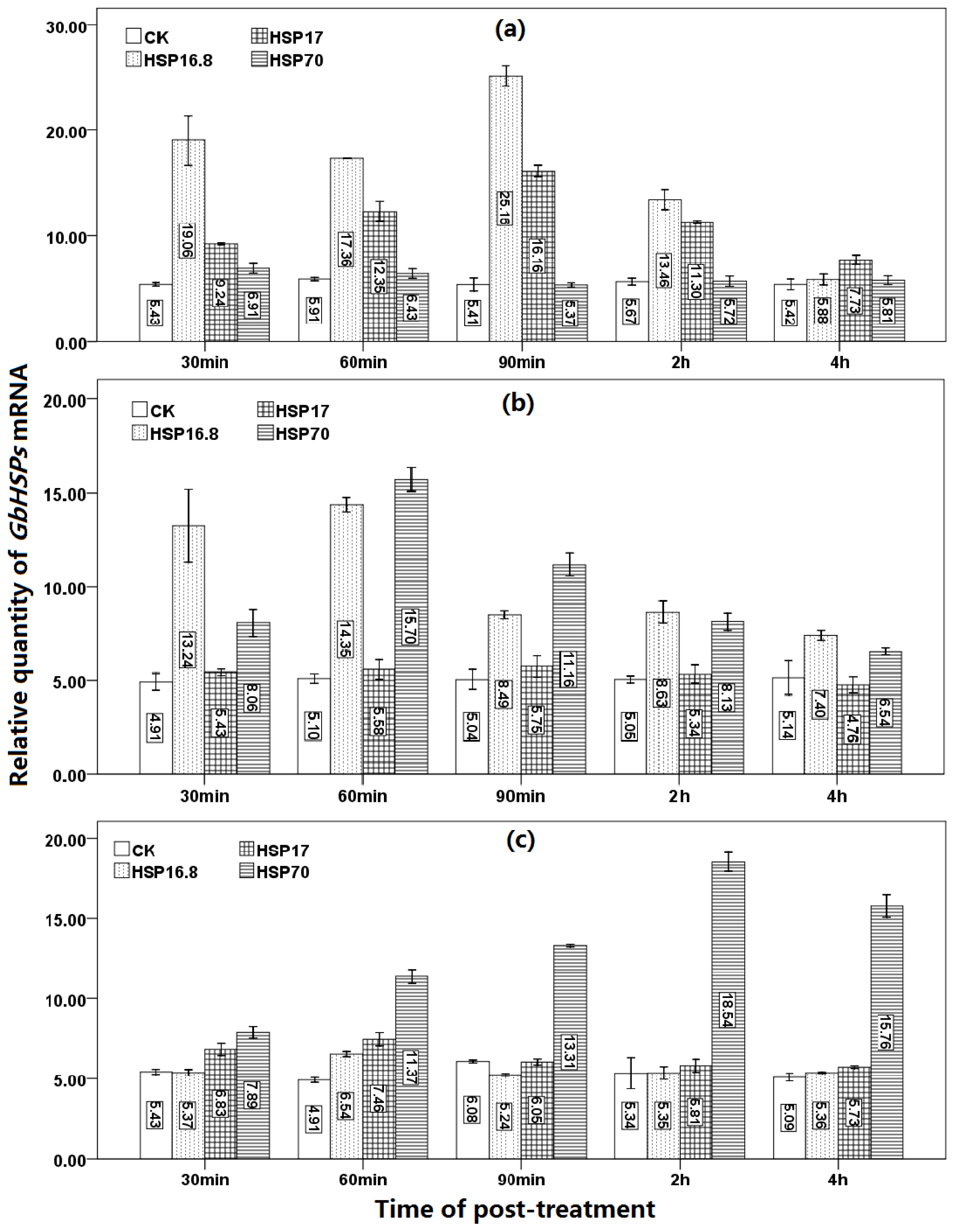
| Primer | Sequence (5′–3′) | Description |
|---|---|---|
| H70R5 | TGTTCCGCATGTTGTAGGCATAGTT | Reverse primer for 5′RACE, outer |
| H70R3 | CTATTCCCACAAAGAAAGAGCAGGTT | Forward primer for 3′RACE, outer |
| H17R5 | GGTTTAGGTTCAGGTTGTTTAGGCAC | Reverse primer for 5′RACE, outer |
| H17R3 | CCAGGTTTGAAGAAAGAGGAGGTTA | Forward primer for 3′RACE, outer |
| H16R5 | TGCCGACTCTTCGCTCCATTCTTAT | Reverse primer for 5′RACE, outer |
| H16R3 | TAAGAATGGAGCGAAGAGTCGGCAAAT | Forward primer for 3′RACE, outer |
| H70N5 | CTTTGTGGGAATAGTAGTGTTT | Reverse primer for 5′RACE, nested |
| H70N3 | ATGGCATCCTTAATGTCTCA | Forward primer for 3′RACE, nested |
| H17N5 | CGATGCCATTTGTCATTCTT | Reverse primer for 5′RACE, nested |
| H17N3 | CCTGAGAATGCCAAGGTAGA | Forward primer for 3′RACE, nested |
| H16N5 | GCTTTCTCATCTCGCTTTCG | Reverse primer for 5′RACE, nested |
| H16N3 | CGTTACGGTTCCCAAGATTC | Forward primer for 3′RACE, nested |
| H70T1 | ACCAATGACAAGGGTAGG | Primer for QRT-PCR, forward |
| H70T2 | TGTAGGCATAGTTCTCCAAT | Primer for QRT-PCR, reverse |
| H17T1 | CTCACATCTTCAAGGCTGATC | Primer for QRT-PCR, forward |
| H17T2 | CTTCTTCTTTGCTGCGTTCT | Primer for QRT-PCR, reverse |
| H16T1 | GAGCGAAGAGTCGGCAAATT | Primer for QRT-PCR, forward |
| H16T2 | TAGCACGCCATCGTAACACG | Primer for QRT-PCR, reverse |
| GAPU | TGTCACGGTTTTCGGTTGTAG | Control Primer for QRT-PCR, forward |
| GAPD | ACCTTTTTGGCACCTCCCTTA | Control Primer for QRT-PCR, reverse |
© 2012 by the authors; licensee Molecular Diversity Preservation International, Basel, Switzerland. This article is an open-access article distributed under the terms and conditions of the Creative Commons Attribution license (http://creativecommons.org/licenses/by/3.0/).
Share and Cite
Cao, F.; Cheng, H.; Cheng, S.; Li, L.; Xu, F.; Yu, W.; Yuan, H. Expression of Selected Ginkgo biloba Heat Shock Protein Genes After Cold Treatment Could Be Induced by Other Abiotic Stress. Int. J. Mol. Sci. 2012, 13, 5768-5788. https://doi.org/10.3390/ijms13055768
Cao F, Cheng H, Cheng S, Li L, Xu F, Yu W, Yuan H. Expression of Selected Ginkgo biloba Heat Shock Protein Genes After Cold Treatment Could Be Induced by Other Abiotic Stress. International Journal of Molecular Sciences. 2012; 13(5):5768-5788. https://doi.org/10.3390/ijms13055768
Chicago/Turabian StyleCao, Fuliang, Hua Cheng, Shuiyuan Cheng, Linling Li, Feng Xu, Wanwen Yu, and Honghui Yuan. 2012. "Expression of Selected Ginkgo biloba Heat Shock Protein Genes After Cold Treatment Could Be Induced by Other Abiotic Stress" International Journal of Molecular Sciences 13, no. 5: 5768-5788. https://doi.org/10.3390/ijms13055768
APA StyleCao, F., Cheng, H., Cheng, S., Li, L., Xu, F., Yu, W., & Yuan, H. (2012). Expression of Selected Ginkgo biloba Heat Shock Protein Genes After Cold Treatment Could Be Induced by Other Abiotic Stress. International Journal of Molecular Sciences, 13(5), 5768-5788. https://doi.org/10.3390/ijms13055768




